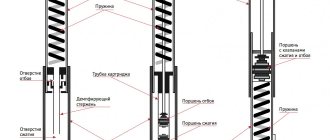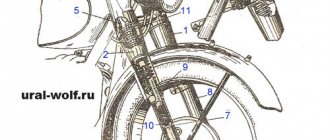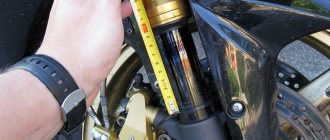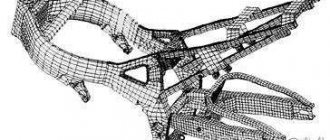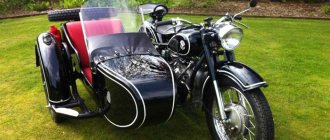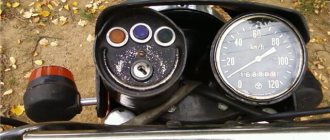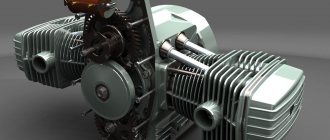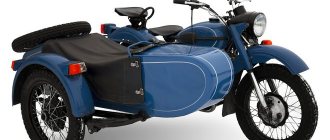In the rear suspension, it is easy to see both components: the spring and the shock absorber. Any road surface (yes, even fresh asphalt) has some unevenness. When driving over such uneven surfaces, the wheel may bounce and lose contact with the surface. When the wheel is not in contact with the road, it is not able to influence the trajectory of the motorcycle. In other words, the motorcycle becomes uncontrollable at these moments.
This phenomenon is partially smoothed out by the shock-absorbing properties of the tire itself. However, this is not enough. To more effectively combat unevenness, a suspension is used.
The main purpose of the suspension is to ensure constant high-quality contact of the wheel with the road surface.
The operation of the suspension has a significant impact on the contact patch of the wheel and, as a result, on the force of adhesion of the wheel to the road.
The suspension, as a rule, has two main parts: an elastic element (spring) and a damper (shock absorber).
Shock absorber
Any spring, if compressed and then released, begins to vibrate. The main task of a shock absorber in a suspension is to dampen (absorb) spring vibrations. The shock absorber converts the vibration energy of the spring into thermal energy (the fluid inside the shock absorber heats up, after which the heat is dissipated).
Properly selected and adjusted suspension components can significantly improve handling. At the same time, a faulty suspension can cause a sharp deterioration in the behavior of the motorcycle. The suspension must always be in good condition.
Suspension travel
In the front suspension - fork, the springs as well as the damping element are located inside the fork body.
During operation, the suspension is constantly compressed and unclenched, working out uneven surfaces. The travel of the suspension between the fully compressed and fully uncompressed states is called the travel stroke. The optimal operating mode of the suspension is achieved in the middle of its operating stroke. Towards the ends of the working stroke, the quality of the suspension deteriorates.
Also, the suspension can be compressed and unclenched under the influence of inertial forces acting on the motorcycle as it accelerates. When accelerating, the front and rear suspensions relax. When braking with the engine or rear brake, both suspensions are compressed. When braking with the front brake, the front suspension compresses and the rear suspension expands.
Modernity
Front suspension
The most widespread today is the classic telescopic fork, which has become a compromise option. It consists of two telescopic tubes, each of which is divided into two halves that slide inside each other. These pipes contain spring-hydraulic shock absorbers, which are responsible for absorbing the energy of impacts and subsequent vibrations. Unlike hydraulic shock absorbers of previous modifications, this suspension design provides separate compression and rebound valves, which allows you to regulate the dynamics of these processes separately from each other. Thanks to this, it is possible to adapt the parameters of the front suspension to individual preferences and even to the weight of the motorcycle owner.
However, the telescopic fork has several significant disadvantages. The first is represented by the low rigidity of this design, which leads to unstable behavior of the motorcycle on a bad road. This problem can be partially solved by making the pipes thicker and wider, but this increases the weight of the motorcycle and complicates its design. In addition, as a result of constant friction of the pipe surfaces against each other, they wear out quite quickly, which forces the front suspension to be frequently repaired. This disadvantage is combated with the help of special polymer and composite coatings.
In addition, if other types of suspensions involve damping vibrations by shortening the wheelbase of the motorcycle, here this happens by reducing the length of the fork itself. Due to this, when braking, the motorcycle noticeably sags on the front wheel, which negatively affects handling and comfort. Various engineers have proposed their own methods of combating front suspension sagging. However, the Honda design turned out to be the most successful - when you press the brake, the caliper moves slightly and closes the valve, which makes the suspension more rigid. Unlike Yamaha designs and other analogues, in this case there were no difficulties when driving over uneven surfaces - if the motorcycle hit a bump, the spring-loaded valve automatically opened, which made it possible to return the suspension to its previous state.
BMW considers the telescopic front suspension of a motorcycle to be obsolete and is actively promoting a design that is structurally similar to a car chassis. Its essence lies in the use of a parallelogram fork, which is attached to the steering column using an articulated lever. At the same time, the shock absorber connects the fork through a special lever not to the column, but to the frame, which allows you to completely eliminate the transmission of vibrations and vibrations to the steering wheel, making control much more convenient. The simplified design uses a single pivot arm that attaches to the telescopic fork cross member and is also connected to the frame via a shock absorber. The advantage of this suspension design is increased comfort and ease of control, but many motorcyclists call the disadvantage the lack of “road feel” - they claim that they cannot react in a timely manner to changes in the road situation without feeling the quality of the road surface.
Back in the 20s, a cantilever front suspension was invented, which made it possible to connect the steering column and motorcycle frame to the front wheel using a single lever. However, it became widespread only in the late 80s, which is associated with the emergence of new high-strength materials. The arm of such a suspension is attached through a shock absorber in a telescopic pipe to an arched additional frame, and is also connected to the steering column through a hinge system. Thanks to this, it is possible to reduce the dimensions of the front suspension of the motorcycle, as well as completely eliminate all the shortcomings of the telescopic fork! However, even in this case, a compromise has to be made - the cantilever mounting of the wheel limits its rotation angle, and the use of ultra-strong alloys and small-scale design increases the cost of the motorcycle.
Rear suspension
Modern manufacturers have gotten rid of rigid and spark plug structures, adopting a lever design for constructing the rear suspension of motorcycles. Its main element is the so-called pendulum - a long lever that is attached to the frame using hinges and connected to the rear wheel axle. The most primitive version of this design is the rear suspension with an H-shaped pendulum and two vertical shock absorbers. It has quite large dimensions, and also cannot provide sufficiently high rigidity, which forces one to limit the riding speed or increase the weight of the entire motorcycle.
Back in 1977, a suspension based on a monoshock absorber appeared, which was a single block consisting of a spring with a hydraulic vibration absorber. Initially, it was installed directly on the pendulum, which made it possible to increase rigidity and optimize the geometric parameters of the suspension. However, subsequently a design appeared in which the monoshock absorber was attached to a separate mechanism consisting of swing arms, which provided the following advantages:
- Increased range of adjustments;
- Reducing loads on the unit and slowing down its wear;
- The appearance of progressive characteristics - the kinematics of the suspension changed depending on the strength of the loads falling on it.
However, sports motorcycles could not make do with a classic swingarm - they required an extremely rigid structure, which would also provide easy access to the wheel and drive system components. Therefore, in the late 80s, a motorcycle rear suspension with a one-sided cantilever mounting of the rear wheel was developed, which was based on a super-rigid pendulum made of an alloy of non-ferrous metals. For a long time it was used only in motorsports, but since the late 90s, the cantilever swingarm has become practically the new standard for road sportbikes.
An alternative design was proposed by BMW, which again was not satisfied with just fine-tuning and fine-tuning the existing options. In its suspension, called “Paralever”, the monoshock absorber was not mounted in a straight line with the wheel axis, but in one straight line with a cantilever arm, inside of which a driveshaft was passed. This made it possible to improve the performance of the suspension in extreme conditions, as well as increase its travel, which is very important for large off-road motorcycles. Thanks to the presence of an additional lever, which turned the unit into a full-fledged parallelogram, the possibilities for customizing such a suspension were very wide, and it reacted differently to different types of coating.
The progressive suspension from BMW was subsequently improved several times - today motorcycles with the third generation of “Paralever” are produced. The additional lever, which provides progressive characteristics and wide tuning options, has moved upward, a recess has appeared in the rear gear housing to reduce weight, and the monoshock absorber is mounted closer to the frame. Thanks to this, it was possible to achieve a significant reduction in the weight of the structure, as well as ease of changing its parameters and maintenance. At the same time, the strength of the rear suspension of heavy BMW off-road motorcycles has not changed - it began to use titanium-based alloys, which can withstand very heavy loads.
Suspension and lean angle of the motorcycle
As the angle of the motorcycle increases, the performance of the suspension deteriorates. This is caused by the fact that the suspension elements begin to work not perpendicular to the road surface, but at an angle. In this regard, the grip of the tires on the road also deteriorates as the angle of inclination of the motorcycle increases.
It is with this phenomenon that the driving technique known as “hanging over” is associated. By hanging from the motorcycle towards the inside of the turn, the rider allows the motorcycle to be more upright. As a result, the suspension works better and the tires are in better contact with the road.
Flex deck
If you take a closer look at the torsional resistance of modern suspensions, you will realize that a certain range of flexibility is encouraged. Thanks to this, the system absorbs impacts caused by uneven surfaces. In turn, very rigid structures transfer these shocks to the chassis, which can cause steering wheel chatter or vibration, that is, high-frequency vibrations of the front wheel. In addition, the so-called wheel speed curve, i.e., the distance that it travels when the springs are compressed on an uneven road, is close to ideal in a telescopic fork. All other systems, including BMW Duolever, work in the opposite direction to the direction of impact, which is detrimental to comfort.
The aluminum bottom shelf can be up to 100mm high. Attached with three screws, it connects both fork legs while strengthening it. Often too much
Beautiful fixation of the thin-walled but huge front wheel axle of the MV Agusta F4
Large fork piston of the Big Piston type, which goes directly into the shins. Below that are small-diameter traditional fork pistons with rebound damping adjustment (right) and rebound damping, which are housed in a single shock cylinder (called a cartridge).
An example is the targeted flexibility of the shock absorber forks on some racing cars. Strange as it may seem at first glance, the milled upper fork flanges hold the upper shank and allow smaller or larger deformations using deep recesses. That is why massive lower shelves secured with several clamping screws on each leg have almost completely disappeared from sports and production cars.
The very large diameters of the front axles, once installed, for example, in the F-series MV Agusta motorcycles, ensure maximum torsional stability of the legs. The designers also made no changes here and left their diameter at 30-35 mm.
Over the years, many of the shortcomings of the telescopic fork design have been addressed. For example, by coating the surface of the shin with special coatings (for example, titanium nitride), friction is reduced, or by carburizing the friction of Teflon-coated plain bearings operating with sealants is reduced.
